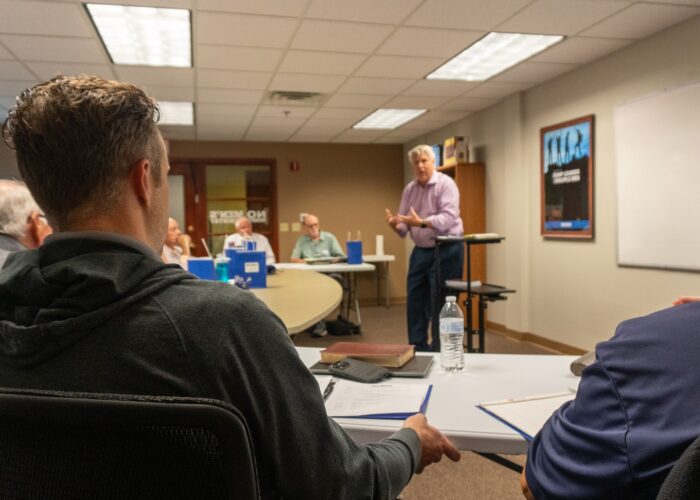John Slack, who led me to the Lord, spent six months meeting with me every week (if not more) to instruct me and build into me the basics of being a disciple of Jesus. Through Bible study, long walks together, serving together, and learning to share my faith, he helped me see that to be a follower of Jesus was an adventure, a lifetime commitment, and that I had the responsibility to do for others what he did for me.
Towards the beginning of our time together, we walked through Robert Coleman’s wonderful book, The Master Plan of Evangelism. Through Coleman’s book, we discovered that Jesus’ entire ministry was predicated on building into and training twelve men whom the multitudes would follow. One quote that to this day continues to make an impact on me is, “One must decide where he wants his ministry to count – in the momentary applause of popular recognition or the reproduction of his life in a few chosen men who will carry on his work after he is gone. Really, it is a question of which generation we are living for.”¹
Early in my ministry, I resolved not to be concerned with the multitudes but instead to take the time to build into a small group of high school students, college students, and then men who would do the same in the lives of others. It is an incredible joy to look back over these years and see so many students and men who have gone on to be fully devoted followers of Jesus and are seeking to do the same in the lives of others. Allow me to share some principles for getting started in this life-changing process.
Intercession. One of the questions I often hear is, “Who do I disciple?” We are to take our cue from Jesus, who spent an entire night praying before asking the original disciples to join Him. You may not spend an entire night praying, but I recommend you prioritize prayer when discerning who God calls you to disciple. Ask God to direct you to the right men and give you divine appointments and connections. As God brings men to mind, or you run into them at church, a gathering, or retreat, write their names down and continue to pray for direction.
Identify a Few. I always look for four qualities when looking for men to pour my life into. I look for men who are FAST.
- Faithful: If you set up a meeting, they will be there. If you ask them to do something, they will do it.
- Available: They are available to meet weekly. Many men today are so busy that they don’t prioritize meeting.
- Spiritual Trajectory: You see in them a desire to grow in their faith.
- Teachable: They want to learn and grow. These men come prepared, have many questions, and have a teachable spirit.
Invite. Having prayed and identified the men God is pointing me to, I will invite them to join a small group with me. In that face-to-face meeting, I will tell them when the group will meet, what we will study, and its purpose. I have found that a good size for a group is 5–8, so each man has a chance to participate. When you invite a man to join your discipleship group, you invite them into a relationship, not a program. They do not want to feel like they are on a “production line” but instead in a long-term relationship based on honesty, authenticity, and love. When inviting a man, I continually try to give them a vision of what they can become and the assurance that I am in their corner, cheering them on and rooting for them. I want them to know that God has a purpose, that He is working in their life, and that He desires to transform them.
Invest. 1 Thessalonians 2:8 is my life ministry verse. The Apostle Paul says, ‘We loved you so much that we were delighted to share with you not only the gospel but our lives as well.’ This verse speaks to this whole idea of life-on-life discipleship. The key principle to remember when working with men is that proximity is essential. You can’t impact men from a distance. The closer you get to them, the greater the impact you will have. If all you do is meet on a Tuesday morning, the impact will be limited. However, if you begin to do things with them outside of group time, like going to a game together, having them over for a meal, or working on a project together, the impact on their life will be greater and more profound. To invest in men involves spending time with them, being authentic with them, being an example for them, encouraging them, and praying for them.
Discipleship is all about the relationship, so to disciple another man invites them into an intimate relationship where growth can occur.
Instruct in the Basics. When I first came to Christ, I remember hearing Howard Hendricks say, ‘Master the Master’s Life.’ This was some of the best advice that I have ever received. The best thing you can do is to get your men into the scriptures and allow the scriptures to speak to them. Too often, we read books about the Bible but are not in the Bible. We sit under the Word but are not in the Word! Start with the gospel of Mark, take one chapter a week, and slowly walk them through the life of Jesus. Focus on learning to live, love, and lead like Jesus. Using the three simple Bible Discovery Study questions below as a guide, you will have deep and wonderful conversations.
- What do we learn about God?
- What do we learn about Mankind?
- What is the application?
Explore our website for resources on how to lead a Bible study, and here is a complete outline of the Gospel of Mark.
Involved in the Work and World. If discipleship depended on passing on information, this country would have the greatest disciples in the world. Unfortunately, that is not what discipleship is about. Discipleship is not about the gathering of information; discipleship is about the transformation of a life. To that end, if our discipleship is going to be effective, it must be experiential and will prepare men to do for others what you did for them. The discipleship must occur in the context of life and be worked out in their daily activities and experiences. The model Jesus gives us in the gospels is the place to start. He did not stop at instructing and illustrating but continued by sending them out to do it as well.
In the same way, you cannot learn to swim by taking an online course, so you cannot become a fully devoted follower of Jesus by just reading a book. You need to jump in and do it. That is why in Luke 10, Jesus sends the disciples out two-by-two to minister. When they return, he debriefs with them, and they go out again. Jesus used this experiential style of training throughout his ministry. I would suggest there were five phases that Jesus walked them through:
- I do—you watch – we talk.
- I do—you help – we talk.
- You do—I help- we talk.
- You do—I watch-we talk.
- You do – someone else watches – you talk.
In the end, we want to launch a movement of discipleship that is making disciples, who make disciples, who make disciples. I pray you have a big enough vision to think small, find some men, and get started.
Robert Coleman, The Master Plan of Evangelism, (Old Tappan: Fleming Revell Company, 1963), p. 37










